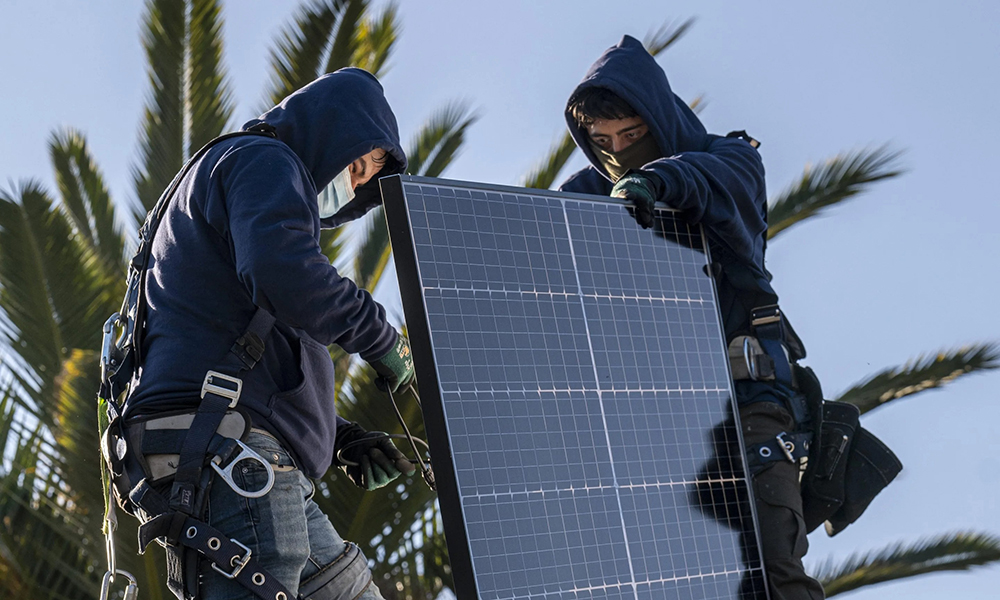
尽管美国的通胀持续打破40年新高,最近大宗商品价格却已经开始有所回落。但有一种重要材料的价格却持续上涨,它就是多晶硅。
这种超导金属是生产太阳能面板的关键材料。7月13日,其价格暴涨2.3%,达到每公斤38.05美元。据中国太阳能行业分析公司索比光伏网(Solarbe)在7月13日发布的一份研究报告显示,自2021年1月以来,多晶硅的价格上涨了超过190%,涨至近10年以来最高水平。
因此,路透社(Reuters)于7月14日报道称,大型项目的太阳能合同价格同比上涨了超过25%。
索比光伏网的分析师认为,如果多晶硅价格持续上涨,就将使全球大型太阳能项目失去经济意义,这会放慢应用清洁能源的速度。
分析师称:“如果硅料价格继续保持高位,所有地面电站项目就都将停滞。”
摩根士丹利(Morgan Stanley)的分析师也支持这种观点。据彭博社(Bloomberg)上周报道,摩根士丹利的分析师在两周前发布的一份报告中表示,全球最大的太阳能开发商、中国公司隆基绿能科技认为,太阳能行业正在接近一个临界点,价格水平的持续上涨将使开发大型太阳能项目毫无意义。
多晶硅价格的变动过程
多晶硅价格的大幅上涨始于2021年全球企业和政府对太阳能发电需求的激增。
例如,去年中国太阳能发电装机容量达到创纪录的54.88千兆瓦。2022年,中国官方预计这个数字将翻一番,全国太阳能发电装机容量将达到108千兆瓦。
2021年,全球企业通过长期项目采购的清洁能源高达31千兆瓦,创下历史纪录,其中太阳能消费占三分之二。
新增的需求导致生产太阳能面板的原材料价格暴涨,包括多晶硅。今年6月,位于中国新疆的一家多晶硅工厂爆炸,导致情况进一步恶化。
中国的太阳能主导地位
国际能源署(International Energy Agency)的官员在最近的一份报告中表示,过去10年,太阳能发电成为全球成本最低的绿色能源,这主要归功于中国在低成本太阳能面板生产领域里扮演的“至关重要的”角色。
唯一的问题是,全世界目前几乎“完全”依赖中国供应生产太阳能面板所使用的基本金属,而且国际能源署预测在2025年之前这种情况不会改变。如果太阳能需求持续增长,而中国的多晶硅生产商不愿意或无法充分增加产量,将会出现问题。
国际能源署的官员说:“任何全球供应链有这种集中程度,都是一个严重的缺点,[而]太阳能光伏也不例外。”
缓解的迹象
好消息是,到今年8月,太阳能行业的困境会有所缓解。
中国有色金属工业协会硅业分会在7月6日的一份报告中表示,由于国内产量增加,预计下个月多晶硅价格将小幅下降。
多晶硅使用冶金级硅制成,之后通过名为西门子(Siemens)工艺的化学提纯过程进行精炼。硅业分会表示,使用这种工艺的工厂最近增加了产量,以满足国内和西方市场日益增长的需求。
美国总统乔·拜登的政府在上个月也宣布,为降低美国能源价格,未来两年将不会对太阳能相关进口产品加征任何关税。拜登总统还授权使用《国防生产法案》(Defense Production Act),以鼓励美国企业生产太阳能面板,对抗中国的市场主导地位。
行业成本下降和太阳能面板供应增加,可以帮助多晶硅的价格在未来几年回落到正常水平。(财富中文网)
翻译:刘进龙
审校:汪皓
尽管美国的通胀持续打破40年新高,最近大宗商品价格却已经开始有所回落。但有一种重要材料的价格却持续上涨,它就是多晶硅。
这种超导金属是生产太阳能面板的关键材料。7月13日,其价格暴涨2.3%,达到每公斤38.05美元。据中国太阳能行业分析公司索比光伏网(Solarbe)在7月13日发布的一份研究报告显示,自2021年1月以来,多晶硅的价格上涨了超过190%,涨至近10年以来最高水平。
因此,路透社(Reuters)于7月14日报道称,大型项目的太阳能合同价格同比上涨了超过25%。
索比光伏网的分析师认为,如果多晶硅价格持续上涨,就将使全球大型太阳能项目失去经济意义,这会放慢应用清洁能源的速度。
分析师称:“如果硅料价格继续保持高位,所有地面电站项目就都将停滞。”
摩根士丹利(Morgan Stanley)的分析师也支持这种观点。据彭博社(Bloomberg)上周报道,摩根士丹利的分析师在两周前发布的一份报告中表示,全球最大的太阳能开发商、中国公司隆基绿能科技认为,太阳能行业正在接近一个临界点,价格水平的持续上涨将使开发大型太阳能项目毫无意义。
多晶硅价格的变动过程
多晶硅价格的大幅上涨始于2021年全球企业和政府对太阳能发电需求的激增。
例如,去年中国太阳能发电装机容量达到创纪录的54.88千兆瓦。2022年,中国官方预计这个数字将翻一番,全国太阳能发电装机容量将达到108千兆瓦。
2021年,全球企业通过长期项目采购的清洁能源高达31千兆瓦,创下历史纪录,其中太阳能消费占三分之二。
新增的需求导致生产太阳能面板的原材料价格暴涨,包括多晶硅。今年6月,位于中国新疆的一家多晶硅工厂爆炸,导致情况进一步恶化。
中国的太阳能主导地位
国际能源署(International Energy Agency)的官员在最近的一份报告中表示,过去10年,太阳能发电成为全球成本最低的绿色能源,这主要归功于中国在低成本太阳能面板生产领域里扮演的“至关重要的”角色。
唯一的问题是,全世界目前几乎“完全”依赖中国供应生产太阳能面板所使用的基本金属,而且国际能源署预测在2025年之前这种情况不会改变。如果太阳能需求持续增长,而中国的多晶硅生产商不愿意或无法充分增加产量,将会出现问题。
国际能源署的官员说:“任何全球供应链有这种集中程度,都是一个严重的缺点,[而]太阳能光伏也不例外。”
缓解的迹象
好消息是,到今年8月,太阳能行业的困境会有所缓解。
中国有色金属工业协会硅业分会在7月6日的一份报告中表示,由于国内产量增加,预计下个月多晶硅价格将小幅下降。
多晶硅使用冶金级硅制成,之后通过名为西门子(Siemens)工艺的化学提纯过程进行精炼。硅业分会表示,使用这种工艺的工厂最近增加了产量,以满足国内和西方市场日益增长的需求。
美国总统乔·拜登的政府在上个月也宣布,为降低美国能源价格,未来两年将不会对太阳能相关进口产品加征任何关税。拜登总统还授权使用《国防生产法案》(Defense Production Act),以鼓励美国企业生产太阳能面板,对抗中国的市场主导地位。
行业成本下降和太阳能面板供应增加,可以帮助多晶硅的价格在未来几年回落到正常水平。(财富中文网)
翻译:刘进龙
审校:汪皓
Commodity prices have begun to cool lately, even as inflation continues to rage at a 40-year high. But one critical metal is heading in the opposite direction—polysilicon.
The price of the ultra-conductive metal that is crucial to the production of solar panels soared 2.3% on July 13 to $38.05 per kilogram. Since January 2021, polysilicon prices have jumped more than 190% to their highest level in a decade, according to a July 13 research note from Solarbe, a Chinese solar industry analysis firm.
As a result, contract prices for solar from large-scale projects are up more than 25% from a year ago, Reuters reported on July 14.
Solarbe analysts argue that if the polysilicon price hikes continue, it could make major solar projects around the world uneconomical, slowing the pace of clean energy adoption.
“If polysilicon prices continue at a high level, all ground utility-scale projects will be stalled,” they said.
Backing up that claim, Morgan Stanley analysts said in a note two weeks ago that the Chinese firm Longi Green Energy Technology, the world’s largest solar developer, believes the industry is nearing a point where price levels no longer make sense for developers of large-scale solar projects, Bloomberg reported last week.
How we got here
The incredible rise in polysilicon prices began with a surge in demand for solar power in 2021 from both corporations and governments worldwide.
China, for example, installed a record 54.88 gigawatts of solar capacity last year. And in 2022, Chinese officials expect to double that figure, installing 108 gigawatts of solar power nationwide.
Corporations worldwide also purchased a record 31 gigawatts worth of clean energy through long-term projects in 2021, with two-thirds of the spending going toward solar.
All of that additional demand has led to skyrocketing prices for the raw materials used in solar panel production, including polysilicon. And an explosion at a polysilicon manufacturing plant in Xinjiang, China, in June has only added to the problem.
China’s solar dominance
Over the past decade, solar power has become the cheapest source of green energy worldwide, largely owing to China’s “instrumental” role in the manufacturing of low-cost solar panels, International Energy Agency (IEA) officials said in a recent report.
The only issue is that the world is now almost “completely” dependent on China to supply the base metals used in solar panel production, and the IEA expects that will remain the case through 2025. That could be a problem if solar demand continues, and China’s polysilicon manufacturers aren’t willing or able to sufficiently increase production.
“This level of concentration in any global supply chain would represent a considerable vulnerability, [and] solar PV [photovoltaics] is no exception,” IEA officials said.
Relief in sight
The good news is that there should be some relief for the solar industry in August.
China’s Silicon Industry Association said in a July 6 report that it expects polysilicon prices to decline slightly next month owing to increasing domestic production.
Polysilicon is made using metallurgical grade silicon, which is then refined through a chemical purification process called the Siemens process. China’s Silicon Industry Association says the factories that use this process have ramped up production recently to help match rising domestic and Western demand.
The Joe Biden administration also announced last month that it wouldn’t impose any new tariffs on solar-related imports for two years in order to reduce U.S. energy prices. And President Biden authorized the use of the Defense Production Act to help encourage U.S. production of solar panels and counter China’s market dominance.
This reduction in industry costs and increase in solar panel supply should help polysilicon prices come back to earth in the coming years.






